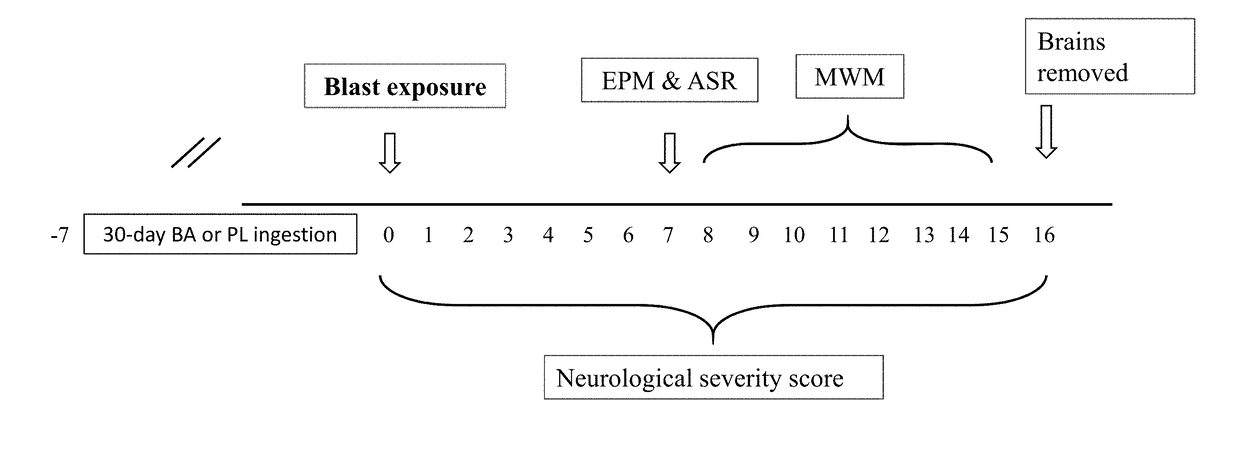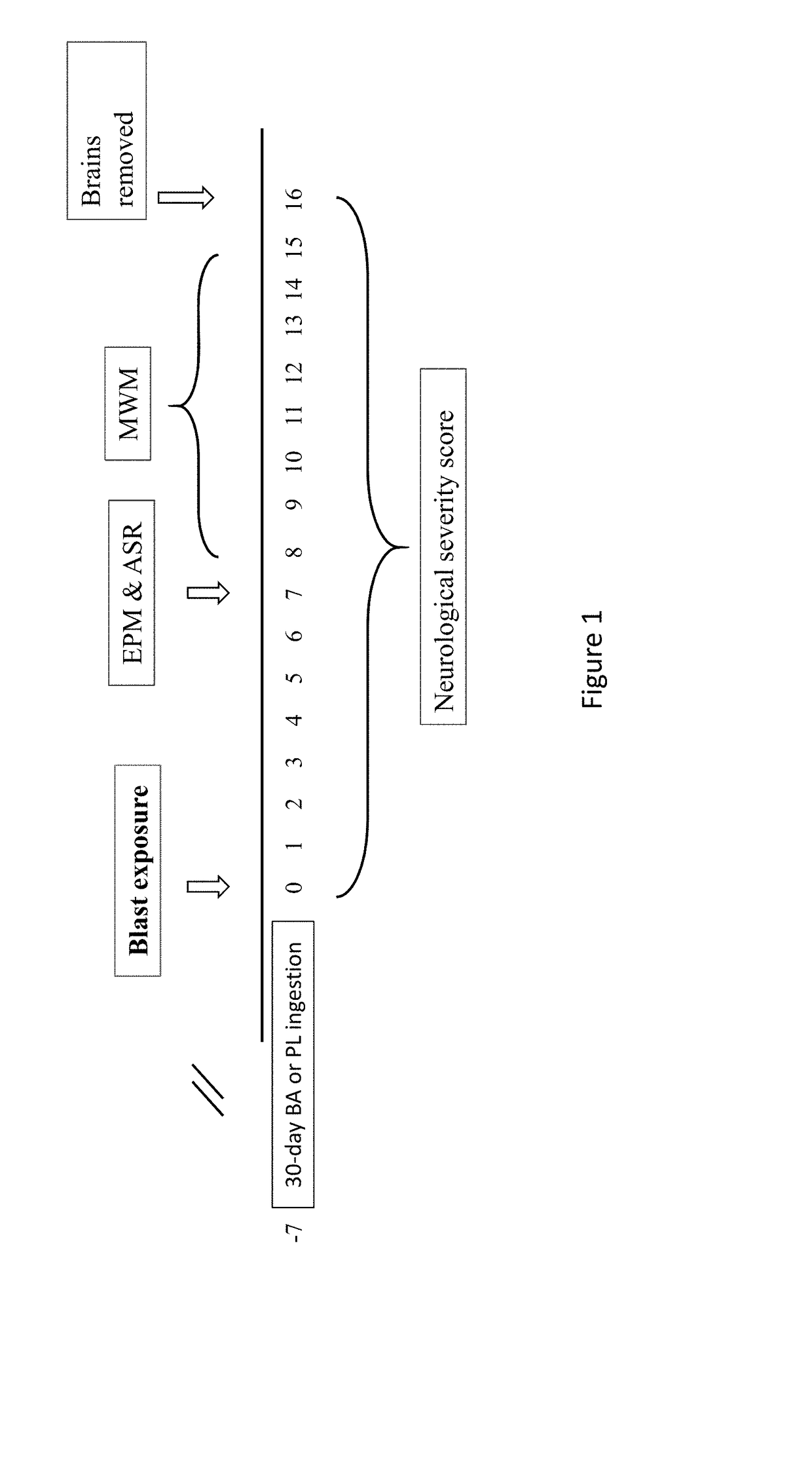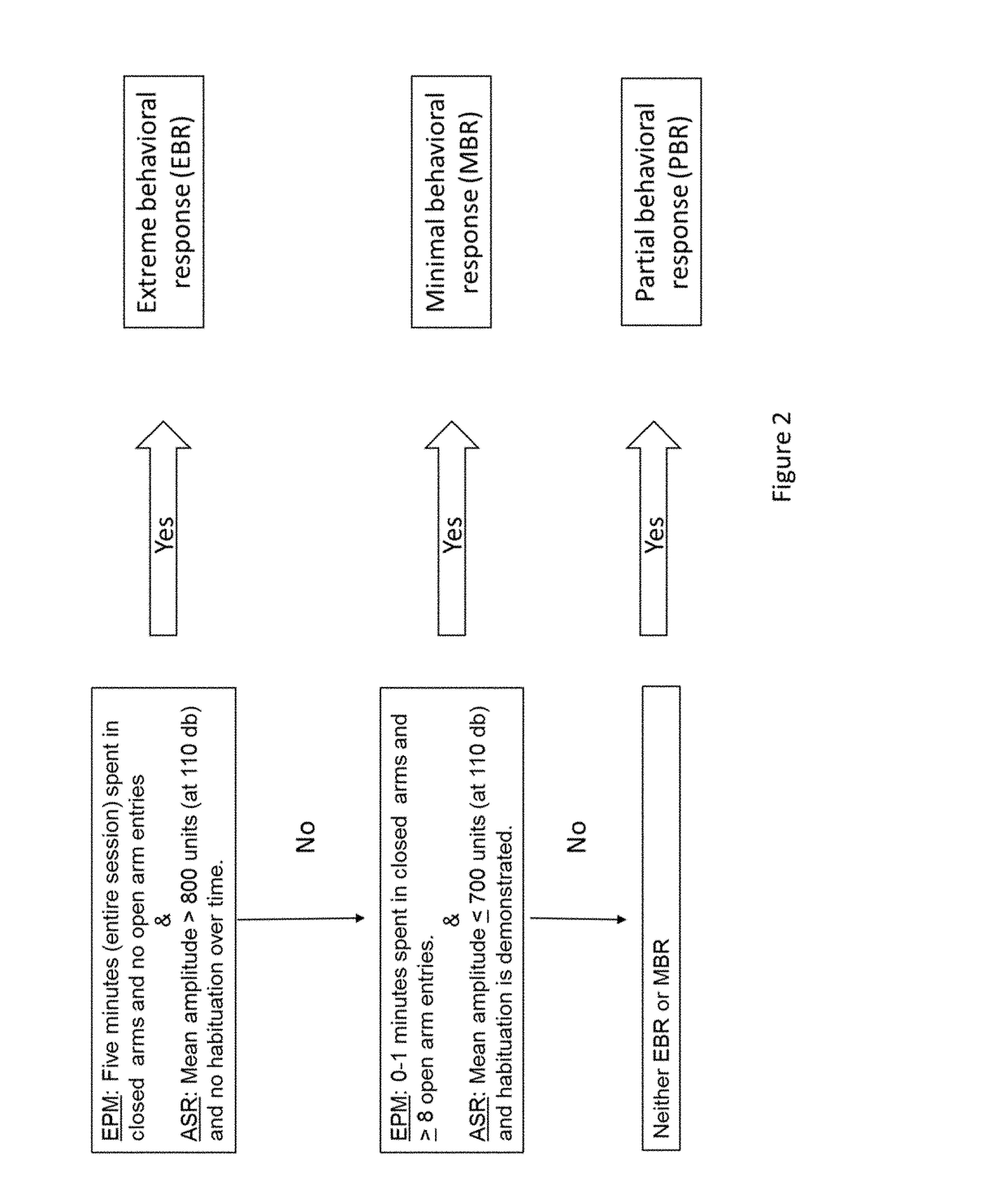Methods of Protecting Against Brain Injury
a brain injury and brain injury technology, applied in the field of brain injury prevention, can solve problems such as vomiting, changes in neural function, and difficulty in concentration, and achieve the effect of reducing the prevalence of mild traumatic brain injury
- Summary
- Abstract
- Description
- Claims
- Application Information
AI Technical Summary
Benefits of technology
Problems solved by technology
Method used
Image
Examples
examples
General Methods
Animals
[0062]Adult male Sprague-Dawley rats weighing 200-250 gm were habituated to housing conditions for at least seven days. All animals were housed four per cage in a vivarium with stable temperature and a reversed 12-h light / dark cycle, with unlimited access to food and water. In animals randomized to the supplement group (BA), β-alanine was provided with glucomannan in a powder form (80:20 blend). Rats were provided with 100 mg of the powder per kg of body mass (a total of 30 mg of powder was dissolved in 25 ml of water). Placebo (PL) treated rats were provided with the vehicle (glucomannan) at the same relative dose. Animals were handled once daily. All testing was performed during the dark phase in dim red light conditions.
Experimental Design
[0063]Rats were randomly assigned to one of three treatment groups:
[0064](1) Vehicle-treated group+Blast (PL; n=50): rats were fed regular food and water for 30 days and exposed to the low-pressure blast wave; (2) β-alanine...
example i
[0082]Prevalence Rates of mTBI, PTSD and mTBI+PTSD According to the Behavioral and Cognitive Performance Criteria
[0083]Significant differences were found between groups in the occurrence of animals fulfilling the criteria for mTBI (χ2=4.05, p=0.044) (see FIG. 4). The prevalence of animals demonstrating mTBI was significantly lower in BA than in PL treated rats (26.5% [ 13 / 49] and 46%, [ 23 / 50], respectively). No significant differences were noted between the groups in the prevalence of animals displaying PTSD-like patterns of behavior (χ2=0.007, p=0.93). The prevalence of PTSD was similar between BA and PL treated rats (10.2% [ 5 / 49] and 12.0% [ 6 / 50], respectively). In addition, the prevalence of animals demonstrating the comorbid pattern of mTBI+PTSD was not significantly different (χ2=1.31, p=0.25) between BA (4%, 2 / 49) and PL (10%, 5 / 50). A trend though was noted (χ2=3.07, p=0.08) in the prevalence of well-adapted animals between the groups. Animals in BA exposed to the low pres...
example ii
BDNF Expression at Day 16 Following Blast Exposure
[0084]Comparisons between BA, PL and CTL for BDNF expression in the CA1, CA3 and DG subregions can be observed in FIGS. 5A-5C, respectively. Significant differences were noted in the CA1 (F (2, 25)=12.9, p<0.001), CA3 (F (2, 25)=11.1, p<0.001) and DG (F (2, 25)=10.5, p<0.001) subregions. BDNF expression in the CA1 subregion of animals not exposed to the blast and fed a normal diet (CTL) were significantly higher than both PL (p<0.001) and BA (p=0.025). BDNF expression in animals that were exposed to the blast and supplemented with β-alanine were significantly higher than PL (p=0.009). BDNF expression in the CA3 subregion in CTL was significantly greater than both BA (p=0.005) and PL (p<0.001). No difference was noted in BDNF expression in CA3 between BA and PL (p=0.110). In the DG subregion, BDNF expression in CTL was significantly greater than both BA (p=0.005) and PL (p<0.001), while no differences were noted in BDNF expression in ...
PUM
 Login to View More
Login to View More Abstract
Description
Claims
Application Information
 Login to View More
Login to View More - R&D
- Intellectual Property
- Life Sciences
- Materials
- Tech Scout
- Unparalleled Data Quality
- Higher Quality Content
- 60% Fewer Hallucinations
Browse by: Latest US Patents, China's latest patents, Technical Efficacy Thesaurus, Application Domain, Technology Topic, Popular Technical Reports.
© 2025 PatSnap. All rights reserved.Legal|Privacy policy|Modern Slavery Act Transparency Statement|Sitemap|About US| Contact US: help@patsnap.com



